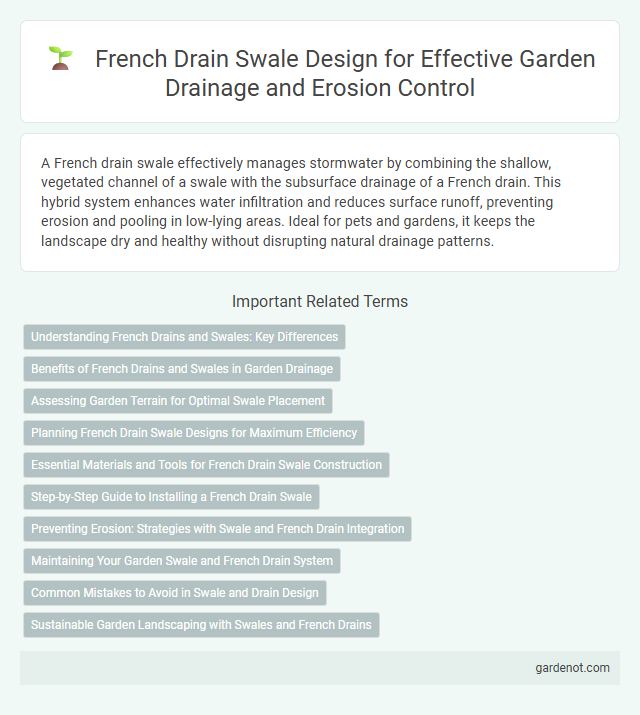A French drain swale effectively manages stormwater by combining the shallow, vegetated channel of a swale with the subsurface drainage of a French drain. This hybrid system enhances water infiltration and reduces surface runoff, preventing erosion and pooling in low-lying areas. Ideal for pets and gardens, it keeps the landscape dry and healthy without disrupting natural drainage patterns.
Understanding French Drains and Swales: Key Differences
French drains and swales both manage stormwater but serve different functions and structures. A French drain is an underground trench filled with gravel and a perforated pipe that redirects water away from areas prone to flooding, while a swale is a shallow, vegetated channel designed to slow water flow and encourage infiltration. Understanding these differences helps optimize landscape drainage, reduce erosion, and protect property from water damage.
Benefits of French Drains and Swales in Garden Drainage
French drains and swales significantly enhance garden drainage by efficiently redirecting excess water away from plant roots, preventing soil erosion and waterlogging. These systems improve soil aeration and reduce standing water, promoting healthier plant growth and minimizing damage from heavy rainfall. Integrating French drains with swales creates a natural, low-maintenance solution for managing stormwater and maintaining optimal soil moisture levels.
Assessing Garden Terrain for Optimal Swale Placement
Assessing garden terrain for optimal French drain swale placement involves analyzing soil type, slope, and drainage patterns to ensure effective water diversion and prevent pooling. Identifying low-lying areas prone to water accumulation helps position the swale where it can intercept runoff and guide excess water away from foundations and plant roots. Proper terrain evaluation enhances the French drain swale's functionality in managing garden water flow and promoting soil health.
Planning French Drain Swale Designs for Maximum Efficiency
Planning French drain swale designs for maximum efficiency involves precise grading to ensure optimal water flow and prevent pooling. Incorporating permeable materials like gravel enhances drainage capacity and reduces soil erosion within the swale. Strategic placement of outlet points directs runoff away from foundations and low-lying areas to promote effective stormwater management.
Essential Materials and Tools for French Drain Swale Construction
Essential materials for constructing a French drain swale include perforated drainage pipes, landscape fabric for soil filtration, gravel or crushed stone to facilitate water flow, and sand for leveling. Tools required encompass a trenching shovel or excavator for digging, a measuring tape for precise layout, a level to ensure proper slope, and a wheelbarrow for transporting materials. Using these materials and tools effectively optimizes soil drainage and prevents water accumulation in the swale area.
Step-by-Step Guide to Installing a French Drain Swale
Installing a French drain swale involves excavating a trench approximately 12 inches wide and 18-24 inches deep along the desired drainage path, ensuring a slight slope for optimal water flow. Line the trench with landscape fabric to prevent soil intrusion, then add a layer of gravel, place a perforated pipe on top, and cover it with more gravel before folding the fabric over and filling the rest with soil. This system efficiently manages surface runoff by directing water away from problem areas, reducing erosion, and promoting proper drainage.
Preventing Erosion: Strategies with Swale and French Drain Integration
Integrating a French drain with a swale effectively prevents soil erosion by enhancing water redirection and infiltration on slopes and low-lying areas. The swale channels surface runoff while the French drain, composed of perforated pipes surrounded by gravel, facilitates subsurface drainage, reducing water pressure on soil and preventing erosion. Combining these systems creates a sustainable water management solution that stabilizes soil, protects landscaping, and minimizes erosion damage during heavy rainfall events.
Maintaining Your Garden Swale and French Drain System
Regular inspection and cleaning of a French drain swale ensure optimal water flow and prevent clogs caused by debris or sediment buildup. Maintaining proper grading and vegetation around the swale reduces erosion and supports effective drainage, protecting garden health. Periodic flushing and removal of accumulated soil from the drain pipes extend the lifespan of the system and prevent water pooling issues.
Common Mistakes to Avoid in Swale and Drain Design
Common mistakes to avoid in French drain swale design include inadequate slope that prevents proper water flow, leading to pooling and ineffective drainage. Using incorrect sizing or materials, such as omitting the gravel layer or perforated pipe, can cause clogs and reduced permeability. Poor placement ignoring natural water runoff paths often results in erosion or water backup, compromising the swale's functionality.
Sustainable Garden Landscaping with Swales and French Drains
French drain swales enhance sustainable garden landscaping by efficiently managing stormwater through natural infiltration and controlled drainage. Incorporating permeable soil layers and gravel in swales with French drains reduces erosion while promoting groundwater recharge and preventing waterlogging. This eco-friendly method supports healthy plant growth, maintains soil integrity, and minimizes runoff in residential and commercial landscapes.
French drain swale Infographic

 gardenot.com
gardenot.com